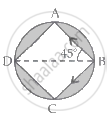Advertisements
Advertisements
प्रश्न
Four identical particles of mass M are located at the corners of a square of side 'a'. What should be their speed if each of them revolves under the influence of the other's gravitational field in a circular orbit circumscribing the square?

विकल्प
`1.35sqrt((GM)/a)`
`1.16sqrt((GM)/a)`
`1.21sqrt((GM)/a)`
`1.41sqrt((GM)/a)`
उत्तर
`underlinebb(1.16sqrt((GM)/a))`
Explanation:
Given: M is the mass of four identical particles placed at the four corners of a square. square edge length = a, Under the influence of each other's gravitational field, the particles revolve in a circular path.
To find: The speed of particles.

The net force on a particle of mass M located at position B will be directed toward the circle's centre:
Fnet = FBD + FBA cos45° + FCA cos45°
= `(GM^2)/(sqrt2a)^2 + (GM^2)/a^2(1/sqrt2) + (GM^2)/a^2(1/sqrt2)`
Square body diagonal BD = `sqrt2`a.
Fnet = `(GM^2)/a^2(1/2 + sqrt2)` ....(i)
Equation (i) represents the net force acting on a particle located at B. It has a centrifugal force.
`(Mv^2)/(a/sqrt2) = (GM^2)/a^2(1/2 + sqrt2)`
`("the distance between location B and the centre of the square is" a/sqrt2).`
`v^2 = (GM)/a(1/(2sqrt2) + 1);`
`v = 1.16sqrt((GM)/a)`
